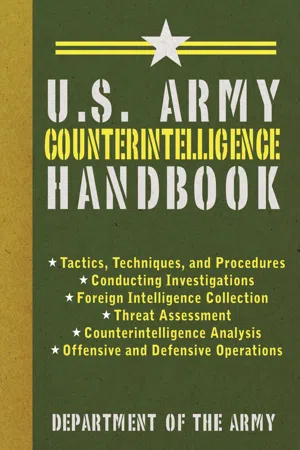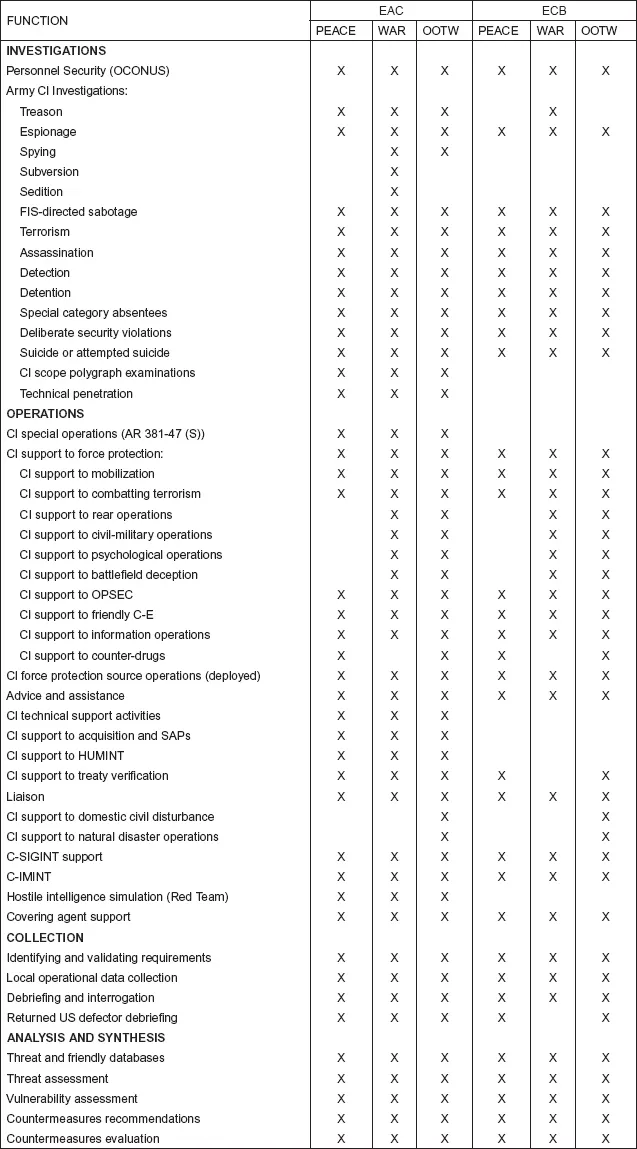
- 296 pages
- English
- ePUB (mobile friendly)
- Available on iOS & Android
eBook - ePub
About this book
The life of a counterintelligence (CI) operative has been immortalized in film and novels as being filled with glamour and excitement. While international travel, heroism, and danger are all part of the job description, the fundamentals of counterintelligence are discipline, skill, and—well—intelligence. CI operations include conducting investigations, offensive and defensive operations, security and vulnerability analyses, and intelligence collection in peace and at all levels of conflict to support command needs. This guide serves to inform commanders, agents, and analysts on how to identify, neutralize, and exploit any foreign attempts to conduct operations against the U.S. Army.
Find out how CI operatives combat terrorism, create battlefield deception, and inform all echelons of combat of both real and potential threats from the U.S. Army's own guide to counterintelligence. The tactics, techniques, and procedures (TTP) outlined are the same instructions that CI personnel follow in the field. As the world becomes more interconnected and as technological advances continue to be made, proper CI techniques are exceedingly critical to the protection of the U.S. Army. Counterintelligence is not just the subject for an entertaining story, it is how peacekeeping, humanitarian, and counter-drug operations are carried out in this globalized world.
Find out how CI operatives combat terrorism, create battlefield deception, and inform all echelons of combat of both real and potential threats from the U.S. Army's own guide to counterintelligence. The tactics, techniques, and procedures (TTP) outlined are the same instructions that CI personnel follow in the field. As the world becomes more interconnected and as technological advances continue to be made, proper CI techniques are exceedingly critical to the protection of the U.S. Army. Counterintelligence is not just the subject for an entertaining story, it is how peacekeeping, humanitarian, and counter-drug operations are carried out in this globalized world.
Frequently asked questions
Yes, you can cancel anytime from the Subscription tab in your account settings on the Perlego website. Your subscription will stay active until the end of your current billing period. Learn how to cancel your subscription.
At the moment all of our mobile-responsive ePub books are available to download via the app. Most of our PDFs are also available to download and we're working on making the final remaining ones downloadable now. Learn more here.
Perlego offers two plans: Essential and Complete
- Essential is ideal for learners and professionals who enjoy exploring a wide range of subjects. Access the Essential Library with 800,000+ trusted titles and best-sellers across business, personal growth, and the humanities. Includes unlimited reading time and Standard Read Aloud voice.
- Complete: Perfect for advanced learners and researchers needing full, unrestricted access. Unlock 1.4M+ books across hundreds of subjects, including academic and specialized titles. The Complete Plan also includes advanced features like Premium Read Aloud and Research Assistant.
We are an online textbook subscription service, where you can get access to an entire online library for less than the price of a single book per month. With over 1 million books across 1000+ topics, we’ve got you covered! Learn more here.
Look out for the read-aloud symbol on your next book to see if you can listen to it. The read-aloud tool reads text aloud for you, highlighting the text as it is being read. You can pause it, speed it up and slow it down. Learn more here.
Yes! You can use the Perlego app on both iOS or Android devices to read anytime, anywhere — even offline. Perfect for commutes or when you’re on the go.
Please note we cannot support devices running on iOS 13 and Android 7 or earlier. Learn more about using the app.
Please note we cannot support devices running on iOS 13 and Android 7 or earlier. Learn more about using the app.
Yes, you can access U.S. Army Counterintelligence Handbook by in PDF and/or ePUB format, as well as other popular books in History & Military & Maritime History. We have over one million books available in our catalogue for you to explore.
Information
Chapter 1
Mission and Structure
General
Threat intelligence services have the capability to conduct continuous collection against the US Army during peacetime, operations other than war (OOTW), and during war itself. The intelligence that results from these operations provides a significant advantage to threat forces, and could easily result in increased US casualties on the battlefield. Fortunately, there are many actions we can take to counter threat intelligence efforts and to provide force protection to all US Army units. The most dramatic of these actions are designed to neutralize enemy collection. These actions include
■ Using field artillery to destroy ground-based enemy signals intelligence (SIGINT) collectors.
■ Conducting sophisticated C-HUMINT operations in a foreign city long before overt hostilities commence.
■ Employing direct fire weapon systems to destroy enemy reconnaissance. Brigades conducting defensive operations at the National Training Center often commit a tank-infantry company team to provide counterreconnaissance, intelligence, surveillance, and target acquisition (C-RISTA) protection.
While not as flashy, routine security procedures provide crucial force protection. These procedures include but are not limited to
■ Personnel security, to include background investigations, will ensure all personnel who have access to sensitive or classified information will fully protect it.
■ Information security, particularly in regard to handling classified and compartmented information, will be a challenging field in the future considering the ease with which information can be copied and transmitted in an increasingly automated Army.
■ Physical security, which ensures physical measures are taken to safeguard personnel, prevents unauthorized access to equipment, installations, materiel, and documents to safeguard them against espionage, sabotage, damage, and theft.
■ Operations security (OPSEC), which ensures that all essential elements of friendly information (EEFI), are reasonably concealed from enemy collection assets.
Another crucial component in the fight against threat collection efforts is CI analysis. These include efforts to identify the general capabilities and specific operations of enemy human intelligence (HUMINT), SIGINT, and imagery intelligence (IMINT) collection. CI analysis also includes the development of profiles that identify friendly vulnerabilities to enemy collection and possible countermeasures.
Measures such as these provide a crucial force protection shield that is difficult for the FIS to penetrate. More importantly, a comprehensive CI program significantly degrades the threat’s ability to target and conduct combat or terrorist operations against US Forces. Total CI provides the combat commander with a definite advantage on the battlefield.
AR 381-10, AR 381-12, and AR 381-47 (S) contain policies and procedures governing the conduct of intelligence activities by Department of the Army (DA).
Mission
The CI mission is authorized by Executive Order (EO)12333, implemented by AR 381-20. The Army conducts aggressive, comprehensive, and coordinated CI activities worldwide. The purpose is to detect, identify, assess, counter, neutralize, or exploit threat intelligence collection efforts. This mission is accomplished during peacetime and all levels of conflict. Many CI functions, shown in Figure 1-1, are conducted by echelons above corps (EAC); some by echelons corps and below (ECB); and some are conducted by both. Those CI assets found at ECB respond to tactical commanders. EAC assets respond primarily to commanders of intelligence units while supporting all commanders within their theater or area of operations (AO).

Figure 1-1. Counterintelligence functions.
The essence of the Army’s CI mission is to support force protection. By its nature, CI is a multidiscipline (C-HUMINT, C-SIGINT, and C-IMINT) function designed to degrade threat intelligence and targeting capabilities. Multidiscipline counterintelligence (MDCI) is an integral and equal part of intelligence and electronic warfare (IEW). MDCI operations support force protection through OPSEC, deception, and rear area operations across the range of military operations. For more information on IEW operations, see FM 34-1.
CI in Support of Force XXI
CI must meet the goals and objectives of Force XXI and force projection operations. US Forces will be continental United States (CONUS)-based with a limited forward presence. The Army must be capable of rapidly deploying anywhere in the world; operating in a joint or combined (multinational) environment; and defeating simultaneous regional threats on the battlefield; or conducting OOTW. CI, as part of IEW, is fundamental to effective planning, security, and execution of force projection operations. Successful force projection CI support is based on the same five key principles shown in Figure 1-2 and discussed below. CI, in support of force protection, will be required on the initial deployment of any force projection operation.
The Commander Drives Intelligence:
The commander focuses on the intelligence system by clearly designating his priority intelligence requirements (PIR), targeting requirements and priorities. He ensures that the Intelligence Battlefield Operating System (BOS) is fully employed and synchronized with his maneuver and fire support BOSs. He demands that the Intelligence BOS provides the intelligence he needs, when he needs it, and in the form he needs.
Intelligence Synchronization:
The J2 or G2 synchronizes intelligence collection, analysis, and dissemination with operations to ensure the commander receives the intelligence he needs, in the form he can use, and in time to influence the decisionmaking process. Intelligence synchronization is a continuous process which keeps IEW operations tied to the commander’s critical decisions and concept of operations. CI collection, analysis, and dissemination, like other intelligence, have to meet the commander’s time requirements to be of any use other than historical.
Split-Based Operations:
Split-based operations provide deploying tactical commanders with a portion of their collection assets and augment full employment of organicassets. Split-based intelligence operations employ collection and analysis elements from all echelons, national to tactical, in sanctuaries from which they can operate against the target area.
Tactical Tailoring:
In force projection operations, the commander tactically tailors CI, as well as all IEW, support for each contingency based on the mission and availability of resources. He must decide which key CI personnel and equipment to deploy early, and when to phase in his remaining CI assets.
Broadcast Dissemination:
Broadcast dissemination of intelligence includes the simultaneous broadcast of near-real time (NRT) CI from collectors and processors at all echelons. It permits commanders at all echelons to simultaneously receive the same intelligence, thereby providing a common picture of the battlefield. It allows commanders to skip echelons and pull CI directly from the echelon broadcasting it.

Figure 1-2. Principles of force projection IEW operations.
Intelligence Tasks
Army military intelligence (MI) accomplishes its mission by performing six primary tasks: providing indications and warnings (I&W); performing intelligence preparation of the battlefield (IPB); performing situation development; supporting target development and targeting; developing force protection intelligence; and performing battle damage assessment (BDA).
CI Tasks
The role of CI is to support the commander’s requirements to preserve essential secrecy and to protect the force directly or indirectly. Thus, CI contributes to the commander’s force protection programs. Force protection is a command responsibility to protect personnel, equipment, and facilities. To carry out his force protection responsibilities, a commander requires support from several sources, one of which is the intelligence community. CI support to force protection must be tailored to the sensitivity of the supported organization and its vulnerability to FIS and hostile attack. CI support can be tailored from a combination of activities to include
■ Mobilization security, including ports and major records repositories.
■ Combatting terrorism.
■ Rear operations.
■ Civil-military affairs.
■ Psychological operations (PSYOP).
■ Battlefield deception.
■ OPSEC.
■ Friendly Communications-Electronics (C-E) (C-SIGINT).
■ CI force protection source operations (CFSO).
Arm...
Table of contents
- Cover
- Title Page
- Copyright
- Contents—FM 34-60
- Preface
- Chapter 1 Mission and Structure
- Chapter 2 Investigations
- Chapter 3 Operations and Techniques
- Chapter 4 Counterintelligence Collection Activities
- Chapter 5 Counterintelligence Analysis and Production
- Appendix A Counter-Human Intelligence Techniques and Procedures
- Appendix B Counter-Signals Intelligence Techniques and Procedures
- Appendix C Counter-Imagery Intelligence Techniques and Procedures
- Glossary
- References